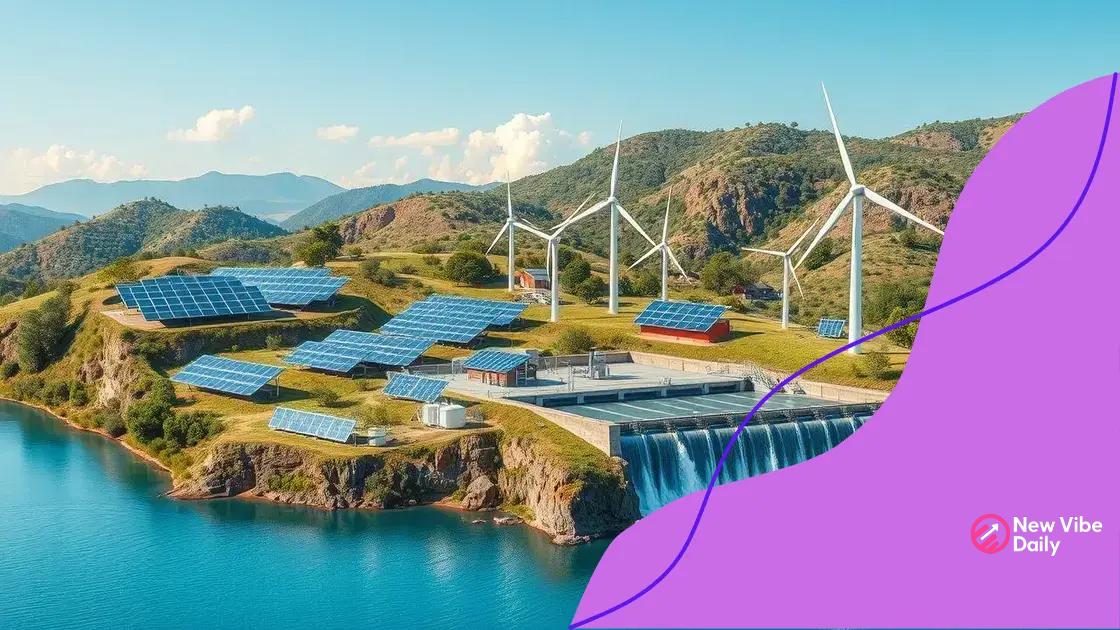Discussions on climate change mitigation strategies

Climate change mitigation involves adopting renewable energy, engaging communities, and implementing supportive policies to reduce greenhouse gas emissions and foster sustainability.
Discussions on climate change mitigation strategies are more relevant than ever as we face global environmental challenges. How can we all contribute to the solution? Let’s explore together.
Understanding climate change and its impacts
Understanding climate change and its impacts is crucial to addressing the challenges we face today. It affects our environment, economy, and health in many ways.
The scientific consensus is that climate change is driven primarily by human activities, especially through the burning of fossil fuels. As we release greenhouse gases into the atmosphere, we enhance the natural greenhouse effect, resulting in global warming.
Key Effects of Climate Change
Some of the significant impacts of climate change include:
- Rising sea levels: Melting ice caps and glaciers contribute to higher ocean levels, threatening coastal communities.
- Extreme weather events: Increased frequency of hurricanes, droughts, and floods disrupt lives and economies.
- Biodiversity loss: Many species struggle to adapt to changing climates, leading to habitat destruction and extinction.
- Health risks: Climate change exacerbates air quality issues, spreading diseases and impacting food security.
By understanding climate change, we can better prepare to tackle its consequences. For instance, adapting our infrastructure can help communities cope with the rising waters and increased storms.
The Connection to Socio-Economic Factors
Socio-economic factors play a significant role in influencing a region’s vulnerability to climate change. Areas with fewer resources often have a reduced ability to prepare for and adapt to extreme weather. This means that poorer communities may bear the greatest burden of climate impacts.
Working together on solutions is essential. Public awareness can drive changes in behavior and promote sustainable practices in our everyday lives. Reducing our carbon footprint through simple actions like recycling, conserving energy, and using public transport can contribute to the larger effort.
In conclusion, comprehending the nuances of climate change empowers us to make informed decisions. We all have a role to play in mitigating the impacts for the benefit of future generations.
Key strategies for mitigating climate change
Key strategies for mitigating climate change involve a combination of innovative methods and collective action. Addressing this complex issue requires a multi-faceted approach that balances technology, policy, and community efforts.
Renewable Energy Adoption
One of the most effective strategies is the transition to renewable energy sources. By shifting away from fossil fuels, we can significantly reduce greenhouse gas emissions. Some popular forms of renewable energy include:
- Solar power: Harnessing sunlight with solar panels is a clean, abundant source of energy.
- Wind energy: Wind turbines convert wind power into electricity, reducing reliance on fossil fuels.
- Hydropower: Using flowing water to generate electricity, this method uses natural resources sustainably.
- Geothermal energy: This taps into the Earth’s internal heat for power, reducing emissions further.
Investment in these technologies is vital, as they not only reduce carbon footprints but also create jobs and stimulate local economies.
Enhancing Energy Efficiency
Improving energy efficiency in homes, businesses, and transportation can lead to significant reductions in energy consumption. Simple actions, such as:
- Using energy-efficient appliances
- Implementing smart building systems
- Promoting public transport to reduce car emissions
- Encouraging proper insulation in buildings
These can drastically lower energy demand, thus decreasing our overall carbon footprint while saving money in the long run.
Protecting and restoring forests also plays a critical role in mitigating climate change. Trees absorb carbon dioxide, making them natural allies in our fight against global warming. Policies that promote afforestation and sustainable land management can greatly enhance these efforts.
Another important strategy is engaging communities in climate action. Educating the public about the impact of climate change and actionable steps they can take empowers individuals to make a difference. Grassroots movements and community-led initiatives have proven effective in implementing local solutions.
Ultimately, a combination of technology, policy changes, and personal responsibility will be critical in building a sustainable future. By implementing these key strategies for mitigating climate change, we can work towards a healthier planet for generations to come.
The role of renewable energy in the solution

The role of renewable energy in the solution to climate change is critical. By utilizing sources like solar, wind, and hydropower, we can dramatically lessen our carbon dioxide emissions.
Benefits of Renewable Energy
Renewable energy sources offer several key benefits:
- Reduction in greenhouse gases: Switching to renewables cuts down the harmful emissions that contribute to climate change.
- Energy independence: By harnessing local energy sources, countries can reduce their dependence on imported fossil fuels.
- Job creation: The renewable energy sector is growing rapidly, providing numerous job opportunities in installation, maintenance, and technology development.
- Reduction in air pollution: Using clean energy sources decreases harmful pollutants, leading to improved public health.
As we face escalating climate challenges, the urgency of integrating renewable energy into our energy systems becomes increasingly apparent. Each type of renewable energy plays a specific role. For example, solar energy captures sunlight through solar panels, converting it into electricity. This method is becoming more affordable and efficient.
Wind Energy as a Power Source
Wind energy, generated by harnessing the power of the wind with turbines, provides a significant portion of the energy mix in many regions. It is one of the fastest-growing sources of renewable energy globally.
Moreover, hydropower remains a crucial resource, utilizing flowing water to generate electricity. This form of energy is reliable and capable of producing large amounts of electricity, often contributing significantly to national energy supplies.
Finally, geothermal energy taps into the Earth’s heat. This reliable energy source can provide consistent power with low environmental impact, making it an essential player in a diversified energy strategy.
Transitioning to a sustainable future relies on our collective efforts to expand and improve renewable energy sources. Promoting education on their benefits can help communities adopt these practices, paving the way toward a cleaner and greener planet.
Community engagement in climate initiatives
Community engagement in climate initiatives plays a vital role in addressing climate change. When communities come together, they can create powerful solutions that have a lasting impact.
Building Awareness and Education
Education is the first step to effective engagement. By informing the public about climate change and its effects, communities can inspire action. Workshops and local events can provide valuable information about:
- The science of climate change: Understanding how it affects local ecosystems.
- Personal actions: Simple steps individuals can take to reduce their carbon footprint.
- Community projects: Opportunities to participate in local climate solutions.
These educational initiatives empower residents to take ownership of climate issues and encourage them to advocate for change.
Participating in Climate Projects
Engaging in hands-on projects is another effective way to promote community involvement. Local efforts might include:
- Tree planting: Helping to restore green spaces and absorb carbon.
- Community gardens: Promoting sustainable agriculture and local food systems.
- Recycling programs: Reducing waste and promoting environmental stewardship.
These activities unite residents and foster a sense of pride and responsibility towards the environment.
Moreover, community engagement creates a support network, allowing people to share resources and ideas. When individuals work together, they can amplify their impact. Social media platforms can also be used to connect like-minded individuals, spreading awareness of events and initiatives.
Furthermore, involving local businesses can enhance the outreach of climate initiatives. Partnerships with local organizations can lead to sponsorships for educational events or community clean-ups. Bringing stakeholders together creates a broader support base for climate initiatives.
Ultimately, community engagement is essential for fostering an environment where sustainable practices can thrive. Through collaboration and active participation, communities can mitigate the effects of climate change more effectively.
Policy frameworks supporting climate action
Policy frameworks supporting climate action are crucial for implementing effective strategies against climate change. These frameworks create guidelines and regulations that help governments, businesses, and individuals take meaningful action.
The Importance of Solid Policy Frameworks
Having strong policies in place ensures that efforts are consistent and aligned toward long-term goals. These frameworks can include:
- Regulations: Laws that limit greenhouse gas emissions and mandate energy efficiency standards.
- Incentives: Subsidies or tax breaks for businesses and individuals who invest in renewable energy or reduce waste.
- Funding: Government grants and loans to support sustainable projects and innovations.
- Partnerships: Collaborative initiatives between government and private sectors to tackle climate challenges.
For instance, many countries have established national climate action plans that outline specific targets for reducing emissions. These plans help guide policy decisions, allowing for measurable progress in fighting climate change.
International Agreements and Cooperation
Global cooperation is vital in addressing climate change. Agreements like the Paris Agreement set international goals that countries aim to achieve collectively. Such frameworks encourage nations to commit to specific emission reduction targets and to report on their progress.
Furthermore, climate action policies must consider social equity and sustainability. This ensures that vulnerable communities are not left behind during the transition to a low-carbon economy. Policies that prioritize job creation in green sectors can also help reduce unemployment and boost local economies.
Public participation in policy-making processes is essential. Engaging community members and stakeholders can lead to more effective and inclusive policies. When citizens voice their concerns and ideas, policymakers can better understand the real-world impacts of their decisions.
Ultimately, effective policy frameworks supporting climate action pave the way for a sustainable future. By creating clear guidelines and fostering cooperation, these policies drive progress toward reducing the impacts of climate change.
FAQ – Frequently Asked Questions about Climate Change Mitigation
What are renewable energy sources?
Renewable energy sources are energy that comes from natural resources that replenish more quickly than they are consumed, such as solar, wind, and hydro power.
How can individuals contribute to climate action?
Individuals can contribute by reducing energy consumption, using public transportation, supporting local businesses, and participating in community environmental initiatives.
Why is community engagement important for climate initiatives?
Community engagement fosters collaboration, raises awareness, and encourages individuals to take action towards climate goals, making initiatives more effective.
What are policy frameworks supporting climate action?
Policy frameworks are a set of guidelines and regulations that help govern actions taken to combat climate change, including laws, incentives, and funding for sustainable practices.






